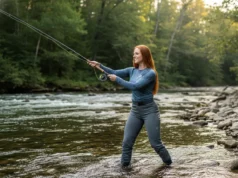In this article
Standing in the fishing aisle can feel like deciphering a foreign language—power, action, gear ratios, graphite vs. fiberglass. It’s a wall of specifications that stands between you and a great day on the water chasing bass, trout, walleye, or inshore redfish. This guide to choosing a fishing combo cuts through that noise. We’ve translated the technical data into real-world performance, creating a simple framework to help you choose the perfect rod and reel combo not just for any angler, but specifically for you. We’ll help you master the language of fishing gear, matching you with top-rated combos tailored to your specific needs, whether you’re a budget-conscious beginner or a dedicated saltwater pro. You will see our objective, data-driven scoring for every product and get clear “Buy If / Don’t Buy If” recommendations. This is your path from gear guesswork to on-the-water confidence.
How to Choose the Right Rod and Reel Combo: An Expert’s Framework
To make a smart, confident choice, you need to turn technical specs into tangible benefits. This framework will arm you with the objective knowledge to do just that, ensuring the gear you choose feels like a natural extension of your arm, whether you’re casting for freshwater bass and crappie or inshore saltwater species like snook.
What’s the Difference Between Rod Power and Action?
Understanding the partnership between rod power and action is the single most important step to matching your gear to your technique. Think of a rod’s Power as its backbone. It’s the fundamental lifting strength, rated from a delicate Ultra-Light rod power for panfish to a winch-like Extra-Heavy for deep-sea monsters like tarpon. A good Medium-Heavy rod is often the sweet spot for many bass fishing applications. This rating directly connects to the weight of the lures you can effectively cast and the size of the fish you’re built to handle. A rod with the wrong power will either feel like a wet noodle when you set the hook on a big catfish or be too stiff to cast a light lure.
Action, on the other hand, describes where the rod bends along its length. An Extra-Fast action rod bends only at the very tip, transmitting every single tick and bump from the lure directly to your hand, which is perfect for feeling the subtle take of a bass on a plastic worm, working a drop-shot rig, a finesse wacky rig, or vertical jigging. A Moderate action rod bends deeper into its mid-section, creating a more parabolic curve. This slower, more forgiving bend acts as a shock absorber, which is crucial for preventing a fish from tearing the treble hooks of a crankbait or spinnerbait out of its mouth during a fight. As you can learn from fisheries experts, this pairing is fundamental to success. For a deeper dive, check out this excellent resource from the Kentucky Department of Fish & Wildlife. This knowledge is the foundation for matching the right spinning rod to your goals.
Pro-Tip: A simple rule of thumb: Use Fast action rods for single-hook lures (jigs, Texas rigs) where you need sensitivity and a quick, powerful hookset. Use Moderate action rods for treble-hook lures (crankbaits, topwaters) to absorb shock and keep fish pinned.
Why Do Rod Materials and Length Matter?
Now that you’ve defined the rod’s characteristics, let’s pair it with the right engine: the reel. The rod material dictates its core trade-offs in performance. Fiberglass rods are durable, flexible, and affordable, but their flexibility means less sensitivity—making them great for beginners or for tossing crankbaits where you don’t need to feel every pebble. Graphite, often graded by modulus like IM7 or IM8, is the opposite: stiff, lightweight, and incredibly sensitive. High-end blanks, sometimes using materials like SCII carbon fiber, offer the ultimate in lightweight and sensitive performance. Composite rods are a blend of the two, offering a versatile middle ground of durability and sensitivity that serves many anglers well.
Rod length is all about the simple physics of casting. Shorter rods, typically between five and seven feet, offer greater accuracy and more leverage for close-quarters casting, like when you’re flipping a jig, pitching to cover, or performing a dock shooting technique for crappie. Longer rods, eight feet and up, generate a higher tip speed during the cast. This translates directly into greater casting distance, which is ideal for surf casting or reaching fish from the shore.
Fishing Rod & Reel Combos
Detailed comparison of popular spinning and spincast combos based on key attributes.
Ratings
Durability: 4.8
Construction: 4.8
Performance: 2.5
Smoothness: 2.5
Sensitivity: 3.0
Ergonomics: 3.5
Balance: 3.5
Key Features
Extremely durable and virtually unbreakable construction, making it an excellent choice for beginners and anglers who need a robust setup. The value is a key highlight.
Ratings
Durability: 4.5
Construction: 4.5
Performance: 2.8
Smoothness: 2.8
Sensitivity: 2.0
Ergonomics: 3.8
Balance: 3.8
Key Features
A classic and reliable spincast combo known for its ease of use and durability. The value is exceptional, making it a perfect starting point for new anglers or kids.
Ratings
Durability: 3.5
Construction: 3.5
Performance: 3.8
Smoothness: 3.8
Sensitivity: 3.5
Ergonomics: 3.7
Balance: 3.7
Key Features
A reliable and balanced spinning combo from a top brand. Offers a good balance of performance and value, suitable for anglers looking for a step up in quality without a high price tag.
Ratings
Durability: 3.0
Construction: 3.0
Performance: 4.5
Smoothness: 4.5
Sensitivity: 3.8
Ergonomics: 4.0
Balance: 4.0
Key Features
Known for its exceptionally smooth retrieve and casting performance. While its durability ratings are slightly lower, it excels in feel and handling for more experienced anglers.
How Do Gear Ratios and Bearings Affect a Reel?
A smooth reel is great, but a powerful drag system is what prevents a trophy fish from breaking your line. The Gear Ratio, written as something like 6.4:1, simply tells you how many times the spool turns with one full rotation of the handle. A low gear ratio provides more torque from the main pinion gear, acting like a winch for pulling deep-diving crankbaits that have a lot of resistance in the water. A high ratio, 7.x:1 or higher, is faster and picks up line quickly. This speed is essential for techniques like jigging or pitching, where you need to reel in slack line instantly to set the hook.
When it comes to Bearings, it’s crucial to dispel the “more is always better” myth. The quality of the bearings is far more important than the sheer quantity. Look for shielded or sealed stainless steel bearings. A quality reel with even a 4-bearing system of sealed stainless steel ball bearings and a solid anti-reverse clutch will outperform a cheap 10-bearing reel every time.
Pro-Tip: A reel with a high bearing count but unsealed, low-quality steel will feel gritty and fail much faster, especially in saltwater, than a reel with fewer, high-quality sealed bearings. Quality over quantity always wins.
Our Selection Process: How We Built This Guide
To build absolute trust, we want to transparently detail our rigorous research and curation process. This guide is built on a foundation of data, not brand loyalty. Our goal is to empower you with unbiased information to make the best possible choice for your needs. Every product we recommend was systematically scored against five critical performance criteria: Durability & Construction, Performance & Smoothness, Sensitivity, Ergonomics & Balance, and Overall Value. We started with a comprehensive market analysis of over 50 combos, then filtered them through expert reviews and user feedback. The top contenders were then mapped to the distinct needs of our three core angler personas.
A Note on Affiliate Links: If you choose to purchase through a link on this page, we may earn a small commission at no extra cost to you. This helps support our independent research and testing. We only recommend gear we believe in.
The Best Rod and Reel Combos of 2025: Our Top Recommendations for Every Need
Here they are: the top recommendations curated specifically for key angler profiles. We’ve done the homework so you can spend less time guessing and more time fishing.
Our Top Picks for The Budget-Conscious Beginner
For the angler just starting their journey or looking for a durable rod-and-reel option without breaking the bank, these combos offer the best performance and longevity for the price. They are built to be reliable, forgiving, and ready to target anything from panfish and trout to bass and catfish.
Our Top Picks for The All-Around Freshwater Enthusiast
This serious angler fishes regularly, targets species like bass and walleye, and demands a higher level of performance. You understand the trade-offs and are looking for a lightweight, sensitive, and powerful tool that can handle a wide range of techniques, from a finesse Ned rig to a heavy spinnerbait, without compromise.
Our Top Picks for The Dedicated Saltwater Angler
Saltwater is an unforgiving environment that destroys lesser gear. This angler needs a workhorse—a combo built with corrosion-resistant materials, sealed components, and the raw power to stop strong, hard-running fish like snook, redfish, and even juvenile tarpon. For surf casting or inshore fishing, a reliable workhorse combo is a necessity.
Conclusion
Ultimately, the “best overall combo” is the one that aligns perfectly with your target species, your go-to techniques, and your budget. There is no single “best for everyone.” Remember to match the rod’s power and action to your lures—Fast actions for sensitive, single-hook techniques like jigging or fishing a Ned rig, and Moderate actions for shock absorption with treble hooks. For beginners, durability is key, while enthusiasts should prioritize sensitivity and reel smoothness. For saltwater, sealed components and robust construction are absolutely non-negotiable. Armed with this knowledge, you’re ready to make a confident choice. Pick the combo from our list that best fits your angler profile and get ready to spend less time guessing and more time fishing.
Frequently Asked Questions about Rod and Reel Combos
What is the best all-around rod and reel combo for a beginner?
When considering a rod and reel combo vs separate components, a combo is the most convenient and affordable choice for a beginner. A 6’6″ to 7′ spinning rod with Medium rod power and Fast rod action is the most versatile ready to go combo, capable of handling a wide variety of lures and species. For an excellent balance of performance and near-indestructible durability, we recommend the Ugly Stik GX2 Spinning Combo.
Is a more expensive fishing combo worth it?
It depends on your needs; more expensive combos typically offer lighter weight, greater sensitivity (from higher-quality graphite or carbon-fiber scii blank materials), and smoother, more durable reels with better drag systems. For a serious angler, this performance advantage is worth the investment, with a combo like the Abu Garcia Revo X Spinning Combo providing a noticeable upgrade.
What’s more important: the rod or the reel?
The fishing rod is arguably more important as it dictates sensitivity, casting performance, and what techniques you can effectively use. While a quality reel is crucial for a smooth experience and fighting fish, the rod is your primary connection to the lure and the bite. A great rod can make a decent reel feel better, but even a premium reel can’t fix a durable rod that has no sensitivity.
How do I know what size reel to get?
Reel size (e.g., a 2000-series ultralight reel, a versatile 3000-size spinning reel, or a larger 4000) should be matched to the rod to ensure the entire setup is balanced. A 3000-size reel is often considered part of the best rod and reel combo for bass fishing versatility, while saltwater anglers targeting larger species will need 4000-size reels or larger like the one included with the PENN Battle IV Spinning Combo.
Risk Disclaimer: Fishing, boating, and all related outdoor activities involve inherent risks that can lead to injury. The information provided on Master Fishing Mag is for educational and informational purposes only. While we strive for accuracy, the information, techniques, and advice on gear and safety are not a substitute for your own best judgment, local knowledge, and adherence to official regulations. Fishing regulations, including seasons, size limits, and species restrictions, change frequently and vary by location. Always consult the latest official regulations from your local fish and wildlife agency before heading out. Proper handling of hooks, knives, and other sharp equipment is essential for safety. Furthermore, be aware of local fish consumption advisories. By using this website, you agree that you are solely responsible for your own safety and for complying with all applicable laws. Any reliance you place on our content is strictly at your own risk. Master Fishing Mag and its authors will not be held liable for any injury, damage, or loss sustained in connection with the use of the information herein.
Affiliate Disclosure: We are a participant in the Amazon Services LLC Associates Program, an affiliate advertising program designed to provide a means for us to earn advertising fees by advertising and linking to Amazon.com. As an Amazon Associate, we earn from qualifying purchases. We also participate in other affiliate programs and may receive a commission on products purchased through our links, at no extra cost to you. Additional terms are found in the terms of service.





